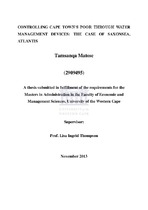| dc.contributor.advisor | Mazvimavi, Dominic | |
| dc.contributor.advisor | Gush, Mark | |
| dc.contributor.author | Manamathela, Sibongile Amelia | |
| dc.date.accessioned | 2016-01-25T15:03:28Z | |
| dc.date.available | 2016-01-25T15:03:28Z | |
| dc.date.issued | 2014 | |
| dc.identifier.uri | http://hdl.handle.net/11394/4751 | |
| dc.description | >Magister Scientiae - MSc | en_US |
| dc.description.abstract | Rapidly increasing global population is adding more pressure to the agricultural sector to produce more food to meet growing demands. However the sector is already faced with a challenge to reduce freshwater utilisation as this sector is currently using approximately 70% of global water freshwater resources. In South Africa, the agriculture sector utilizes approximately 62% of freshwater resources and contributes directly about5% to the Gross Domestic Product. South Africa is a water scarce country receiving less than 500mm/year of precipitation in most parts of the country, and consequently approximately 90% of the crops are grown under irrigation. Studies have evaluated irrigation practices and crop water use in the country. However information is lacking on the full impact of South African horticultural products on freshwater resources. The water footprint concept can be used to indicate the total and source (blue/green) of water used to produce the crops. Information about water footprint (WF) can be used for identifying opportunities to reduce the water consumption associated with production of vegetables and fruits at the field to farm- gate levels, including the more effective use of rainfall (green water) as opposed to water abstracted from rivers and groundwater (Blue water). It can also be used to understand water related risks associated with the production of crops and facilitate water allocation and management at catchment/water management scale. While the potential value of water footprint information is well recognized there is still inadequate knowledge on how best to determine the water footprints of various crops within a local context. The aim of this study was to determine the water footprint and the crop water productivity of navel oranges, pink lady apples and potatoes produced with the Olifant/Doorn water management area in South Africa.The water footprint of the navel oranges, pink lady apples and potatoes assessed following the water footprint network method was 125 litres/ kg, 108 litres/kg and 65 litres/ kg respectively. The study concluded that water footprint studies should be carried out on the whole catchment instead of one farm in order to assess the sustainability of the process. | en_US |
| dc.language.iso | en | en_US |
| dc.publisher | University of the Western Cape | en_US |
| dc.subject | Crop water use | en_US |
| dc.subject | Water footprint | en_US |
| dc.subject | Blue water | en_US |
| dc.subject | Green water | en_US |
| dc.subject | Reference evapotranspiration | en_US |
| dc.subject | Crop water productivity | en_US |
| dc.title | The water footprint of selected crops within the Olifants/Doorn Catchment, South Africa | en_US |
| dc.rights.holder | University of the Western Cape | en_US |




